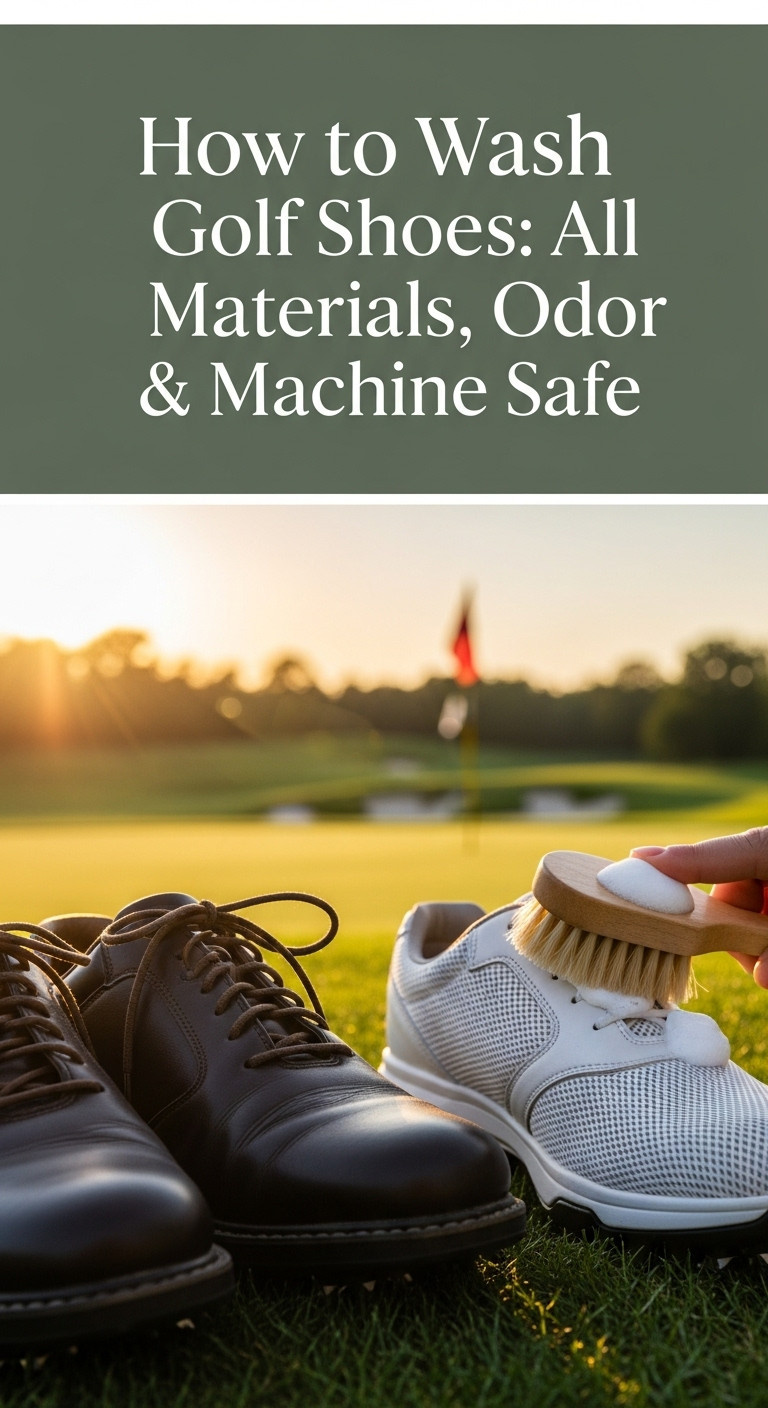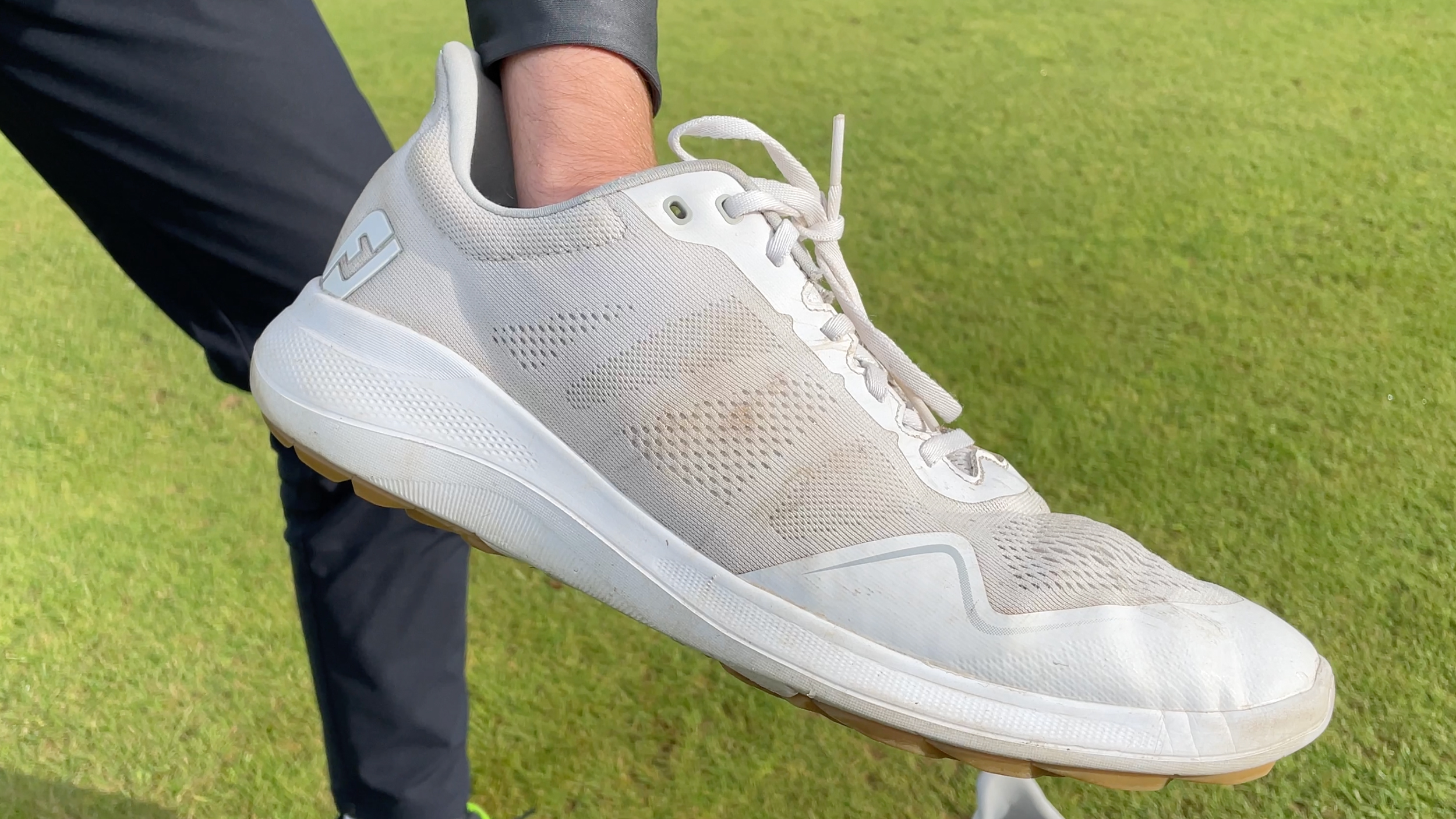As an Amazon Associate GolferHive.com earns from qualifying purchases.
How to Wash Golf Shoes: All Materials, Odor & Machine Safe
Keeping your golf shoes clean isn’t just about looking sharp on the first tee; it’s a critical part of protecting your investment and ensuring they perform as designed, round after round. Yet, with so many different materials and conflicting advice, knowing the right way to wash them can be confusing, leaving many golfers worried about causing irreversible damage to expensive footwear. The fear of ruining a waterproof membrane, shrinking leather, or fraying delicate mesh often leads to neglect, which shortens the lifespan of your shoes and can impact your stability on the course.
The safest and most effective way to wash golf shoes is to hand-clean them based on their material. Always begin by removing loose debris and taking out the laces and insoles. Use a mild soap solution and a soft cloth for leather or synthetic uppers, and a soft brush for mesh or knit fabrics.
This guide cuts through the confusion, leveraging expert-backed methods and manufacturer recommendations to provide a definitive step-by-step process. We will unpack the proven, safe techniques for every type of golf shoe material, from premium leather to modern knit designs. You’ll learn the high-risk, high-reward method for machine washing, the simple trick to banish odors for good, and the non-negotiable rules for drying that preserve your shoe’s shape and integrity.
Key Facts
- Material Dictates Method: The cleaning process is entirely dependent on the shoe’s material; leather requires gentle hand-cleaning and conditioning, while some synthetics can handle more rigorous methods, as outlined by sources like FootJoy and Golf.com.
- Heat is the Enemy: Never use direct heat sources like a hairdryer, radiator, or direct sunlight to dry golf shoes. Aggregated expert advice confirms that excessive heat can warp materials, melt adhesives, and shrink uppers, causing permanent damage.
- Cedar Shoe Trees are Essential: Post-cleaning, cedar shoe trees are vastly superior to plastic alternatives. Data from shoe care guides shows they not only maintain the shoe’s shape but also actively absorb residual moisture and neutralize odor-causing bacteria.
- Machine Washing Carries High Risk: While possible for some mesh or synthetic shoes, machine washing is never recommended for leather. Forum discussions among experienced golfers and cleaning guides emphasize this should be a last resort, done infrequently on a delicate, cold cycle.
- Vinegar is a Proven Deodorizer: A simple 50/50 solution of white vinegar and water is a highly effective deodorizer. As highlighted in top search results, its acidic properties neutralize the alkaline bacteria responsible for shoe odor.
Step 1: Essential Pre-Cleaning Prep for All Golf Shoes
Start by knocking off all loose mud and grass with a soft brush, then remove laces and insoles to be washed separately in soapy water. This foundational process, recommended by golf shoe experts and major brands like FootJoy, is the universal first step for any effective cleaning routine. It prevents you from grinding abrasive dirt and grass into the shoe’s delicate upper materials during the actual washing stage, ensuring a deeper, safer clean no matter if your shoes are leather, synthetic, or mesh.

Before you introduce any water or cleaning solution, follow these critical preparation steps:
- Remove All Loose Debris: First, bang the soles of the shoes together outdoors to dislodge large clumps of mud and grass. Use a soft-bristled brush to gently sweep away any remaining dry dirt from the uppers (the main body of the shoe).
- Deep Clean the Soles and Spikes: The bottom of your shoes takes the most abuse. Compacted mud and grass can get stuck between the cleats, reducing traction.
> Pro Tip: Use an old golf tee or a spike wrench to easily dislodge compacted mud and grass from the cleats before you even think about using water. This makes the final cleaning much easier. - Take Out Laces and Insoles: Untie and remove the shoelaces completely. Then, pull out the insoles (the removable padded inserts inside the shoe). This allows you to clean each component thoroughly and ensures the inside of the shoe can dry properly.
- Wash Laces and Insoles Separately: Place the laces in a small bowl of warm water with a bit of mild soap or laundry detergent and let them soak. You can agitate them with your hands to remove grime. For the insoles, gently wipe them down with a damp cloth and a small amount of shoe cleaner, but avoid soaking them completely. Set both aside to air dry.
Step 2: Hand-Washing Your Golf Shoes (The Safest Method)
For all shoe types, hand-washing is the recommended method to protect the material and ensure longevity. The specific technique varies based on whether your shoes are leather or mesh. Manufacturers universally recommend hand-cleaning because it gives you complete control over the amount of water and pressure used, safeguarding delicate materials, waterproof coatings, and the adhesives that hold the shoe together. Think your leather shoes are too far gone? A proper hand clean might surprise you.

For Leather & Synthetic Golf Shoes
Gently wipe leather uppers with a mild soap solution on a soft cloth, rinse with a damp cloth, and always apply a leather conditioner after drying. This gentle approach is crucial for preserving the natural oils in leather and protecting the waterproof coatings common on both leather and synthetic golf shoes. Using harsh detergents or abrasive brushes can strip these protective layers, leading to cracking, discoloration, and water penetration.
Follow this proven 4-step process:
- Mix Your Cleaning Solution: In a small bowl, mix a small amount of mild liquid soap (like dish soap) or a dedicated shoe cleaner with warm water. You want a slightly sudsy solution, not a thick paste.
- Clean the Uppers: Dip a soft cloth or sponge into the solution, wring it out so it’s damp but not dripping, and gently wipe the entire upper of the shoe. Work in small, circular motions to lift away dirt and stains.
- Rinse and Wipe Down: Rinse the cloth thoroughly with clean water, wring it out, and wipe down the shoes again to remove any soap residue.
- Condition and Protect (Crucial for Leather): After the shoes are completely dry, apply a quality leather conditioner or shoe cream. This expert-recommended step is vital for replenishing moisture, maintaining flexibility, and restoring the water-resistant barrier, significantly extending the life of your shoes.
> Quick Fact: For white leather shoes, a dedicated white shoe cleaner not only cleans but also helps cover up stubborn scuff marks. For darker leather shoes, a shoe cream with the corresponding color can restore their look while conditioning them.
For Mesh & Knit Golf Shoes
Use a soft brush and warm, soapy water to gently scrub mesh or knit materials, then blot with a cold, damp cloth to rinse away soap residue. These modern, breathable materials are fantastic on the course but can trap dirt within their weave. The key is to use a method that lifts the dirt out without damaging the delicate fabric.
For a light clean after a dry round, simply brushing off dirt may be enough. For more heavily soiled shoes, follow this deep clean process:
- Prepare the Soak: Fill a sink or bucket with warm water and mix in a gentle liquid dish soap or laundry detergent.
- Soak and Scrub: Let the shoes soak for about 20-30 minutes to loosen embedded dirt. Then, use a soft-bristled brush (an old toothbrush works perfectly) or a soft cloth to gently scrub the mesh uppers, paying extra attention to stained areas.
- Rinse Carefully: Instead of running the shoes under a faucet, which can force water into the padding, blot the mesh with a cloth dampened with cold, clean water. This effectively removes the soap residue without over-saturating the shoe.
CAUTION: While mesh is durable, aggressive scrubbing can fray the material. Use a soft brush and let the soapy water do most of the work. Patience is key to cleaning these materials without causing damage.
Step 3: Machine Washing Golf Shoes (The High-Risk, High-Reward Method)
For synthetic or mesh shoes only: place them in a laundry bag, wash on a delicate cycle with cold water, and absolutely never put them in the dryer. This method can deliver a deep, restorative clean for certain non-leather shoes, but it comes with significant risks if not done with extreme care.
Warning: This method is ONLY for certain synthetic and mesh shoes. NEVER machine wash leather golf shoes, as it can cause irreversible damage to the material, warping, and delamination. Always check the manufacturer’s care label first. If in doubt, stick to hand-washing.
If you’ve confirmed your shoes are machine-washable and you’re ready to proceed, follow these steps precisely to protect your shoes and your washing machine:
- Perform All Prep Steps: Follow Step 1 exactly. Remove laces and insoles, and thoroughly clean all loose debris and mud from the uppers and soles. You don’t want that grime in your washing machine.
- Bag the Shoes: Place the golf shoes and the separated laces inside a mesh washing bag. This is a critical step.
> Pro Tip: Place the shoes in a mesh washing bag or an old pillowcase to stop them from banging against the drum, which protects both your shoes and your machine. - Add Towels as Padding: Add a few old towels to the washing machine along with the bagged shoes. This balances the load and provides extra cushioning, further preventing the shoes from slamming against the machine’s interior.
- Use the Right Settings: Add a small amount of gentle, liquid laundry detergent. Set the machine to a delicate or gentle cycle using cold water only. Hot water can melt the glues used in shoe construction.
- Air Dry ONLY: Once the cycle is complete, immediately remove the shoes and proceed to the drying steps outlined in Step 5. Again, never put golf shoes in a machine dryer.
| Do’s and Don’ts of Machine Washing Golf Shoes | |
|---|---|
| Do ✅ | Don’t ❌ |
| Use a mesh laundry bag or pillowcase. | Wash leather or suede shoes. |
| Wash on a delicate/gentle cycle. | Use hot water. |
| Use cold water exclusively. | Use powder detergent (can get stuck in fabric). |
| Add old towels for cushioning. | Put them in the machine dryer. |
Step 4: How to Banish Odors from Smelly Golf Shoes
Mix equal parts white vinegar and water in a spray bottle, lightly spray the inside of your shoes, and let them air dry to eliminate odors. After a hot day on the course, even the best-ventilated golf shoes can develop an unpleasant smell. This simple, proven home remedy, directly referenced in top-ranking cleaning guides, tackles the root cause of the problem without harsh chemicals.
The reason this works so well is that the acetic acid in white vinegar effectively neutralizes the alkaline bacteria that thrive in the warm, damp environment inside your shoes and cause the odor.
It’s a simple two-step process:
1. Create the Solution: In a clean spray bottle, combine one part white vinegar and one part plain water. Shake well to mix.
2. Apply and Dry: After your round, lightly mist the inside of each golf shoe with the solution. Don’t saturate them. Then, leave the shoes in a well-ventilated area to air dry completely. The slight vinegar smell will dissipate as it dries, taking the unwanted odors with it.
Step 5: The Critical Rules for Drying and Maintaining Shoe Shape
Always air dry shoes away from direct heat. Use cedar shoe trees immediately after washing to absorb moisture and preserve the shoe’s original shape. How you dry your golf shoes is just as important as how you wash them. Improper drying is the fastest way to ruin a perfectly good pair of shoes, causing them to warp, shrink, or become brittle. Protecting your investment means following these non-negotiable drying rules.

Here are the essential do’s and don’ts for drying your golf shoes:
- DO dry them at room temperature in a well-ventilated, shaded area.
- DO use cedar shoe trees to absorb moisture and maintain the shoe’s structure.
- DO open the tongue and loosen the shoes as much as possible to promote airflow.
- DON’T place them near a heater, radiator, fireplace, or vent.
- DON’T use a hairdryer or any direct heat source.
- DON’T leave them in direct sunlight or in a hot car trunk.
Pro Tip: Stuff your shoes with newspaper for the first 30-40 minutes to quickly absorb excess moisture, then replace it with cedar shoe trees for the final drying phase.
Investing in quality shoe trees is one of the best things you can do for your footwear. Here’s why cedar is the undisputed champion:
| Feature | Cedar Shoe Trees | Plastic Shoe Trees |
|---|---|---|
| Moisture Absorption | ✅ Excellent | ❌ None |
| Odor Control | ✅ Naturally deodorizes | ❌ Traps odor |
| Shape Maintenance | ✅ Excellent | ✅ Good |
| Material Longevity | ✅ Extends life of leather | ❌ No benefit |
For best results, a quality golf shoe cleaning kit often provides all the necessary brushes, cleaners, and conditioners to simplify this entire process and ensure you’re using products designed specifically for your footwear.
FAQs About Washing Golf Shoes
What is the absolute best way to clean golf shoes?
The absolute best and safest way to clean any pair of golf shoes is by hand. This method gives you total control, preventing damage to sensitive materials like leather and protecting the waterproof membranes and glues used in construction. The specific technique—using a soft cloth for leather or a soft brush for mesh—should be tailored to the shoe’s material for optimal results.
How can I clean smelly golf shoes effectively?
The most effective way to eliminate odor is to use a 50/50 solution of white vinegar and water. Place the mixture in a spray bottle and lightly mist the inside of your shoes after your round. The vinegar neutralizes odor-causing bacteria. Allow the shoes to air dry completely in a well-ventilated area. Using cedar shoe trees during storage also helps absorb moisture and prevent future odors.
Is it really okay to put my golf shoes in the washing machine?
It is only okay for certain types of golf shoes—specifically those with synthetic or mesh uppers. You should never put leather golf shoes in a washing machine. If you do machine wash appropriate shoes, you must use a mesh laundry bag, a delicate cycle with cold water, and always air dry them afterward. It’s a high-risk method that should be used sparingly.
Can I wash my FootJoy or Callaway golf shoes using these methods?
Yes, these methods are applicable to major brands like FootJoy and Callaway. The key is to identify the material of your specific shoe model first. For their premium leather shoes (like many FootJoy models), strictly follow the hand-washing and conditioning guide. For their athletic-style mesh or synthetic models, you can use the mesh hand-washing method or, with caution, the machine-washing method.
What’s the biggest mistake people make when cleaning their golf shoes?
The single biggest mistake is improper drying. Many people, in a rush to dry their shoes, place them near a heat source like a radiator, in direct sunlight, or even use a hairdryer. This excessive heat can warp the uppers, melt the adhesives holding the sole, and cause leather to crack, permanently ruining the shoes. Always air dry at room temperature.
Final Takeaways: Keeping Your Golf Shoes in Top Condition
Properly knowing how to wash golf shoes is more than just a cleaning chore; it’s essential maintenance that protects your gear, ensures on-course performance, and saves you money in the long run. By following the correct process for your shoe’s material, you can keep them looking and feeling brand new for seasons to come.
Remember these critical rules for golf shoe longevity:
- Always Hand-Wash Leather: Never subject leather golf shoes to the harshness of a washing machine. Gentle hand cleaning and conditioning is non-negotiable.
- Never Use a Machine Dryer: The intense, direct heat from a dryer will destroy your golf shoes. Patience and air-drying are your only safe options.
- Always Use Cedar Shoe Trees: This is the single best thing you can do for your shoes post-round. They absorb moisture, eliminate odor, and perfectly maintain the shoe’s intended shape.
Now that you have the expert-backed process, make it a part of your post-round routine to keep your shoes performing their best!
Post-Round Shoe Care in 5 Minutes
1. Wipe Down: Use a damp cloth to wipe off any fresh dirt or mud.
2. Unlace and Open: Loosen the laces and pull the tongue forward to air out the interior.
3. Deodorize (if needed): A quick spritz of your vinegar-water solution.
4. Insert Shoe Trees: Immediately place cedar shoe trees inside to begin drying and reshaping.
Last update on 2025-12-06 / Affiliate links / Images from Amazon Product Advertising API

